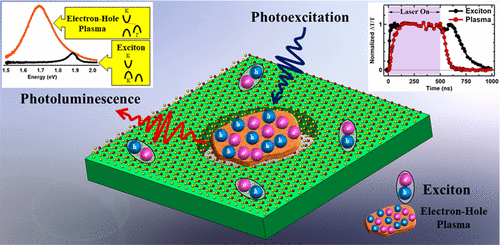Abstract
Many-body interactions in photoexcited semiconductors can bring about strongly interacting electronic states, culminating in the fully ionized matter of electron–hole plasma (EHP) and electron–hole liquid (EHL). These exotic phases exhibit unique electronic properties, such as metallic conductivity and metastable high photoexcitation density, which can be the basis for future transformative applications. However, the cryogenic condition required for its formation has limited the study of dense plasma phases to a purely academic pursuit in a restricted parameter space. This paradigm can potentially change with the recent experimental observation of these phases in atomically thin MoS2 and MoTe2 at room temperature. A fundamental understanding of EHP and EHL dynamics is critical for developing novel applications on this versatile layered platform. In this work, we studied the formation and dissipation of EHP in monolayer MoS2. Unlike previous results in bulk semiconductors, our results reveal that electromechanical material changes in monolayer MoS2 during photoexcitation play a significant role in dense EHP formation. Within the free-standing geometry, photoexcitation is accompanied by an unconstrained thermal expansion, resulting in a direct-to-indirect gap electronic transition at a critical lattice spacing and fluence. This dramatic altering of the material’s energetic landscape extends carrier lifetimes by 2 orders of magnitude and allows the density required for EHP formation. The result is a stable dense plasma state that is sustained with modest optical photoexcitation. Our findings pave the way for novel applications based on dense plasma states in two-dimensional semiconductors.
